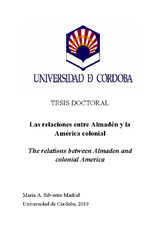Las relaciones entre Almadén y la América colonial
The relations between Almaden and colonial America
Autor
Silvestre Madrid, María A.
Director/es
Hidalgo Fernández, Rafael EnriqueAlmansa Rodríguez, Emiliano
Editor
Universidad de Córdoba, UCOPressFecha
2019Materia
HuancavelicaAzogue
Plata
Intercambio
Almadén (Ciudad Real, España)
Quicksilver
Silver
Exchange
METS:
Mostrar el registro METSPREMIS:
Mostrar el registro PREMISMetadatos
Mostrar el registro completo del ítemResumen
Una de las consecuencias del descubrimiento de América fue la ingente cantidad de plata que produjeron sus yacimientos, de tal forma que la minería argentífera posibilitó que en el Nuevo Mundo, en muy poco tiempo, hubiera un gran desarrollo del comercio y de la agricultura, se trazaran nuevos caminos, se crearan ciudades y se construyeran puertos y astilleros. El descubrimiento del método de amalgamación a mediados del siglo XVI por Bartolomé de Medina en la mina de Pachuca (virreinato de Nueva España), supuso que la mina de Almadén pasara a ser una explotación de enorme importancia, debido a que el azogue, monopolio de la Corona, era el elemento clave para el proceso de amalgamación de los minerales de plata de baja ley. Así pues, el yacimiento de Almadén y también el de Huancavelica surtieron de azogue, el primero de ellos sobre todo a las minas de Nueva España y el segundo a las del Perú. El traslado del azogue a los yacimientos constituyó un primer obstáculo importante por ser un metal líquido y muy pesado, especialmente en el caso de Almadén, pues al transporte terrestre había que añadir el marítimo para cruzar el Atlántico. Una vez en América, todavía habían de recorrerse cientos de leguas hasta alcanzar los Reales de minas de plata, lo que hacía que el azogue que salía de Almadén en la primavera de cualquier año no llegara a su destino final hasta la del año siguiente. Por otra parte, entre Almadén y Huancavelica se estableció una intensa relación de intercambio tecnológico y de gentes. De la mina castellana fueron enviados mineros expertos a la peruana en diversas ocasiones durante el siglo XVII y los hornos de aludeles de Huancavelica se implantaron en Almadén en 1644, funcionando tan bien que se utilizaron en esta mina hasta 1928. Así pues, la minería del azogue constituye un buen ejemplo de reciprocidad entre ambas orillas del Atlántico, lo que posibilitó que el Cerro Rico de Potosí, primero, y Zacatecas, Guanajuato y otras minas de Nueva España, después, convirtieran a la América colonial en la mayor productora mundial de plata durante la Edad Moderna. One of the consequences of the discovery of America was the enormous amount of silver that produced its deposits, in such a way that Argentífera mining enabled the new world, in a very short time, to have a great development of trade and agriculture, New roads will be plotted, cities will be created and ports and shipyards built. The discovery of the method of amalgamation in the mid-sixteenth century by Bartolomé de Medina in the Pachuca mine (viceroyalty of New Spain), assumed that the mine of Almadén became a major exploitation, because the quicksilver, monopoly of the Crown, was the key element in the process of amalgamation of low grade silver minerals. Thus, the site of Almadén and also that of Huancavelica they had of Quicksilver, the first of them mainly to the mines of New Spain and the second to those of Peru. The transfer of the quicksilver to the deposits constituted a first important obstacle because it was a liquid metal and very heavy, especially in the case of Almadén, because the terrestrial transport had to add the maritime to cross the Atlantic. Once in America, they still had to travel hundreds of leagues to reach the real silver mines, which made the quicksilver that came out of Almadén in the spring of any year did not reach its final destination until the next year. On the other hand, between Almadén and Huancavelica an intense relationship of technological exchange and people was established. From the Castellana mine were sent expert miners to the Peruvian on several occasions during the 17th century and the Huancavelica avalanche kilns were implanted in Almadén in 1644, working so well that they were used in this mine until 1928. Thus, the mining of the quicksilver constitutes a good example of reciprocity between both shores of the Atlantic, which made possible that Cerro Rico of Potosí, first, and Zacatecas, Guanajuato and other mines of New Spain, then, converted to the colonial America in the World's largest producer of silver during the modern age.

